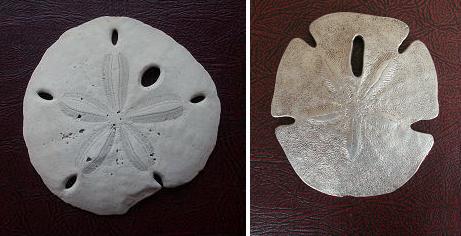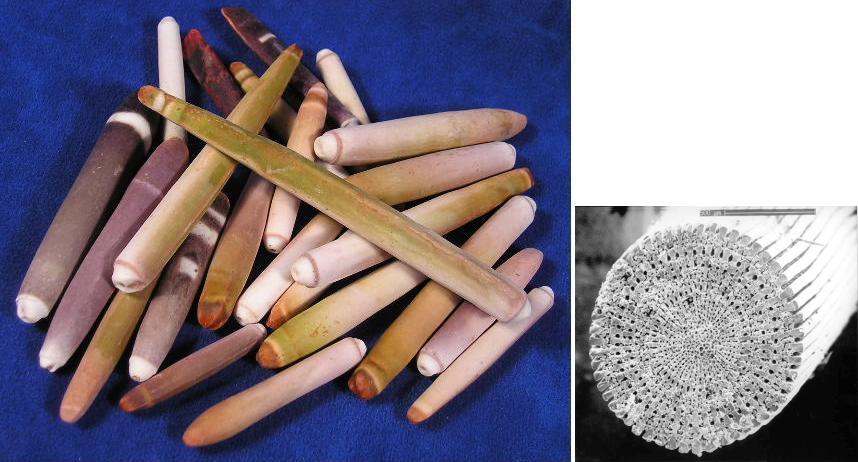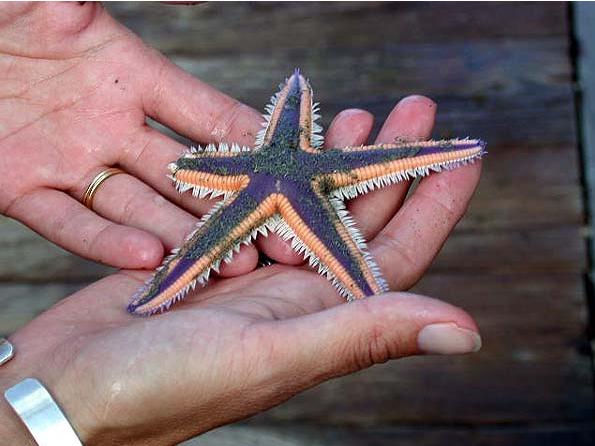SAND
DOLLARS, SEA
URCHINS and STARFISH
(Singular
nouns: Fr-petit
clypéastre, châtaigne
de mer, &
astérie/étoile de mer-?;
Ger-Sand-dollar,
Seeigel,
&
Seestern;
Nor-sand
dollar, kråkebolle, & sjøstjerne; Rus-песок доллар, кожие-?, &
морские везды)

A. Sand
dollar and replica.
Left, sand dollar (?Encope
michelini L. Agassiz, 1841?) (height - 9.2 cm)
collected on Gulf of
Mexico beach, Port Aransas, Texas. Right, pewter replica (height
- 8 cm). (© photos by Dick Dietrich)
B. Sea Urchin - Left, spines
of a "pencil urchin" (which one yet to be determined). (© photo courtesy of Naples Sea Shell
Company; from http://www.naplesseashellcompany.com). Right, cross
section of echinoid spine (© photo
courtesy of Fiona Meldrum,
University of Bristol, Bristol, UK; from http://www.inchm.bris.ac.uk)
C. Starfish "collected in an
area of Savannah Reef called Sow's Pen [off Atlantic coast of Georgia
and South Carolina]. (photo from National
Oceanic and Atmospheric
Administration, U.S. Department of Commerce,
http://oceanexplorer.noaa.gov/)
DESCRIPTION: Phylum, Echinodermata: Sand dollars and sea
urchins (both - class,
Echinoidea)
and starfish (class,
Asteroidea)
are living
representatives of the phylum
Echinodermata used rather
widely
in
jewelry and decorative items. Sea lilies (class,
Crinoidea) and brittle stars (class,
Ophiuroidea), also living
Echinodermata, have also been used in the
"decorative
arts," but only rarely. Sea cucumbers (class,
Holothuroidea), another group of currently
living Echinodermata, are virtually never
so-used. The hard parts of those that are used consist
chiefly of magnesian-calcite with MgCO3-contents ranging between 5
and 15 per cent (Raup, 1966).
Colors - Sand dollars are
typically off white; most sea urchin spines used as
parts of decorative items are purple or brownish purple and
white; the starfish used are typically off-white, ecru, tan or
darker brown, but some
of them are diverse hues of red, orange, yellow or purple or
combinations thereof.
H. (effective hardness) 2½
- 3
S.G. 2.65 - 2.7 (depending
upon sample size and method of measurement; the point being they
are rather porous)
Light transmission -
semitranslucent to opaque
Luster - dull to pearly to
subvitreous
Breakage - irregular
Miscellaneous - All echinoderms are
marine animals. Virtually all hard
parts
of the echinoderms treated in this entry effervesce with dilute HCl
(hydrochloric
acid). The spines of echinoids
that have roles in decorative items are relatively
large (commonly 10 cm long), partially hollow
or filled with a calcium carbonate
mesh, and
tend to jingle when dropped on hard surfaces or
knocked against each other. Sand dollars and sea
urchins are characterized by
a real or at-first-look radial (commonly five-fold) symmetry.
OTHER NAMES: Names other than
the common names given in the title of this entry are sometimes used
for all or parts of these animals and/or their hard parts.
Examples follow:
- asteroid - name
often
applied to starfish.
- echinoid
- This more appropriate, in my opinion, term is frequently applied to
sea urchins; it also is applied, though only rarely, to sand
dollars.
- pencil
spines - name frequently applied to spines of the "pencil
urchins" -- Several
species have been called pencil or slate pencil urchins -- e.g., Eucidaris tribuloides (Lamarck,
1816), Arbacia punctulata
(Lamarck, 1816) and Heterocentrotus
mammillatus (Linnaeus, 1758).
- sea star
- designation sometimes used in lieu of starfish.
USES:
Jewelry: Beads -- Spines of
pencil urchins have been used in necklaces, both
in groups and as
central pendants, and for bracelets. Columnals of sea lilies
(i.e., stem sections of crinoids,
class Crinoidea), which are hollow disks, have been used for
necklaces. -- Indeed, some fossil columnals that have been
weathered
out of rocks have been used,
especially those found (and worn!) by beach combers.
Decorations -- Sand dollars
(see
Figure A, Right), sea urchins and
starfish have found wide use as decorative
pieces and parts thereof -- e.g.,
of wreaths.
Mobiles -- Spines of the pencil
urchin have been made into wind chimes -- usually as the
"chimes." For a few, however, these spines serve as the central
weighted units with seashells as the "chimes."
OCCURRENCE & LOCALITIES: Echinoderms
are marine and found sporadically in all oceans.
REMARKS: The designation
Echinodermata stems from the Greek combining form (έχîνος) denoting something
prickly and (δέρματ)
-stem of δέρμα skin. (O.E.D.).
With a few
exceptions, each of the
skeletal units and spines of echinoderms is a single, albeit composite,
magnesium-rich calcite (+
protodolomite)
crystal -- i.e., each
unit consists of
aggregates of microcrystals with parallel
crystallographic
axes (e.g., Raup, 1959
&1966; Towe, 1967; Schroeder et
al., 1969). The units "may articulate with
one another,
as in the
flexible sea
stars and brittle stars, ... [or be so-to-speak] fused
together to
form a rigid
skeletal test ... in sea urchins and sand dollars. ..."
(Ruppert, Fox and Barnes, 2004, p. 873). In any case, "in the living
organism, the
stereom does
not show the characteristic cleavages of the calcite, because of its
latticed structure and the presence, in the meshes of the calcareous
network, of the organic stroma." (Ubaghs, 1967, p. S14-S15). One of the
more interesting and apt
descriptions follows: "Echinoderms have
been compared to living, moving castles. Castles are made of
interlocking blocks, with a single main entrance and numerous slit
windows for air and for defense. Echinoderm skeletons are made up of
interlocking calcium carbonate plates and spines..." (The Museum of
Paleontology ... University of California
...,1994).
Sand dollars are whitened by flushing them with water (in some cases
with a little added bleach), dried and then coated (for
example, using a sponge) with a roughly 50:50 mixture of water and
white glue. Sea urchin spines' soft tissue can be removed by
treating them "with 5% sodium hypochlorite for several hours, ...
[then] washed several times in water, adjusted to pH 7.3, and, finally,
air
dried" OR "removal of the stroma [may be effected] with
Chlorox" (Davies, Crenshaw and Heatfield, 1972, p.876 & 877).
Starfish, once cleaned, can be soaked in isopropyl alcohol
for a few hours and then dried; in some cases the legs need
to be weighted down so they do not curl during the drying.
On the basis of
a study of the echinoid Arbacia
punctulata
(Lamarck, 1816), it seems that spines
of
echinoids, if broken will regenerate and grow to their
original lengths, even restoring their characteristic patterns (Davies,
Crenshaw and Healthfield, 1972).
One
of the unfortunate things
relating with some of these echinoderms is that they are seldom
found where they were washed up on beaches (and virtually never, in the
numbers needed to fulfill the "needs" of fashioners who use them and
the marketers of the products). Even more unfortunate is the fact
that this "predicament" has led to "fishing" for live individuals,
AND, several of them have become endangered species.
SIMULANTS:
Although
some people might consider some of the things listed under REPLICAS to
be simulants, it is my opinion that none do. As a matter of fact,
I have
seen neither records nor examples of any thing that I think would
qualify as a
simulant rather than a replica.
REPLICAS: Molds
made from sand dollars and starfish are used to cast
metals and alloys --
e.g., copper, gold or silver
and brass or pewter (Fig. A, right); they are marketed widely,
especially
in
souvenir shops near sea
coasts where
these natural animals are found on beaches.
Some of the casts that are used are made in molds prepared from
"sculptures" of brass made from molds
of the natural marine forms. Most life-size replicas are too large for
adornment and consequently are used for decorative pieces for mantels,
whatnots, etc. Other
replicas in this general size category , but poor because their
relative dimensions are not realistic, are used for things such as Christmas tree
ornaments, "starfish" that obscure wall hooks, and parts of "wall art"
and wreaths; most consist largely of glass and plastics. A
multicolored (each arm a different color) raku starfish is advertized
as made by South African craftsmen.
Smaller replicas used chiefly for jewelry consist of all the just
mentioned materials, but brass and gold appear to be the choices of
most craftsmen who produce them; additional materials also
frequently used include gemstones (e.g.,
variscite) and enamels.
Most of these replicas are used on bracelets and/or as
pendants, pins and dangling earrings.
An out-of-the-ordinary set, best described as rough replicas, includes
a pendant/pin and matching earrings that consist largely of numerous
"sparkling" faceted "stones" that are vintage jet-black glass.
Recently (2006), I saw a rather attractive,
though highly stylized, starfish replica made of opal
glass and marketed for use as a paperweight and, an equally attractive
life-sized sea urchin-like mass made of glass that is said to include
"a pinch of ash from the 1980 eruption of Mount St. Helens." Indeed, the use of
things made to resemble different echinoderms could be
extended "on into the night ..." -- Think about the advertisement in a recently
distributed mail-order
catalog
from a specialty house that featured such things as three "Starfish sculptures" fashioned from wire mesh (the
largest more
than two feet across and sea
urchin-shaped vases, which consist of cast resin, that are up to a foot
in diameter.
Virtually two-dimensional starfish-like forms also adorn diverse items
that reange from expensive leather items (e.g., bejeweled purses) to
inexpensive (cheap!!) clothing (e.g., low grade T-shirts).
R.V.
Dietrich © 2015
Last update: 28 January 2014
web page created by Emmett Mason


